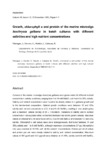Growth, chlorophyll α and protein of the marine microalga Isochrysis galbana in batch cultures with different salinities and high nutrient concentrations
Title
Growth, chlorophyll α and protein of the marine microalga Isochrysis galbana in batch cultures with different salinities and high nutrient concentrationsDate
1985Citation
Fabregas J, Herrero C, Abalde J, Cabezas B. Growth, chlorophyll a and protein of the marine microalga Isochrysis galbana in batch cultures with different salinities and high nutrient concentrations. Aquaculture 1985;50(1-2):1-11. http://dx.doi.org/10.1016/0044-8486(85)90147-4
Abstract
Cultures of the marine microalga Isochrysis galbana were grown under 56 different nutrient concentration-salinity conditions, ranging from 1 to 64 mM NaNO3 and from 0 to 35‰ salinity. Salinity and nutrient concentration were found to be closely related to I. galbana growth and to the biochemical composition. Optimal growth conditions were between 15 and 35‰ salinity and nutrient concentrations of 2, 4 and 8 mM NaNO3, resulting in one doubling/day and a maximum cellular density of 20 × 106cells/ml. Variations in salinity and in nutrient concentration had a greater effect on the final biomass than on the growth velocity. Maximum values of chlorophyll α ml were found with 2, 4 and 8 mM NaNO3 and between 15 and 35‰ salinity. Chlorophyll α cell values were more homogeneously distributed between 15 and 35‰ salinity and 1 to 8 mM NaNO3, although maximum concentrations (37 pg chlorophyll α cell) were reached at 10-15‰ with all the nutrient concentrations. Protein per ml of culture and protein per cell were closely related to salinity and nutrient concentration. Maximum values of 387 μg/ml and 18.6 pg/cell were obtained at 15-35‰ salinity and 4-8 mM NaNO3.
The nitrate-protein transformation rate was related to nutrient concentration. Maximum rate was 84% at 15‰ salinity and 1 mM NaNO3. Nutrient concentrations higher than 16 mM NaNO3 produced a strong decrease in the efficiency at all salinities.
Keywords
Salinity
Nutrient concentrations
Growth
Chlorophyll α
Protein
Marine microalgae
Isochrysis galbana
Batch cultures
Nutrient concentrations
Growth
Chlorophyll α
Protein
Marine microalgae
Isochrysis galbana
Batch cultures
Editor version
ISSN
0044-8486






